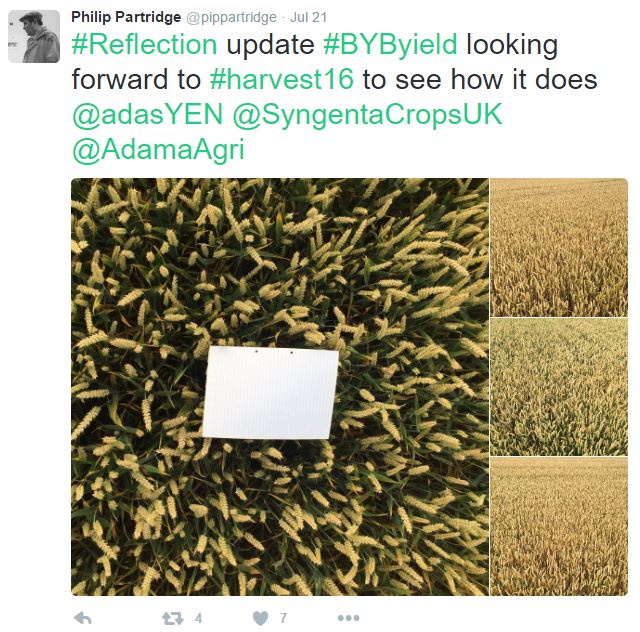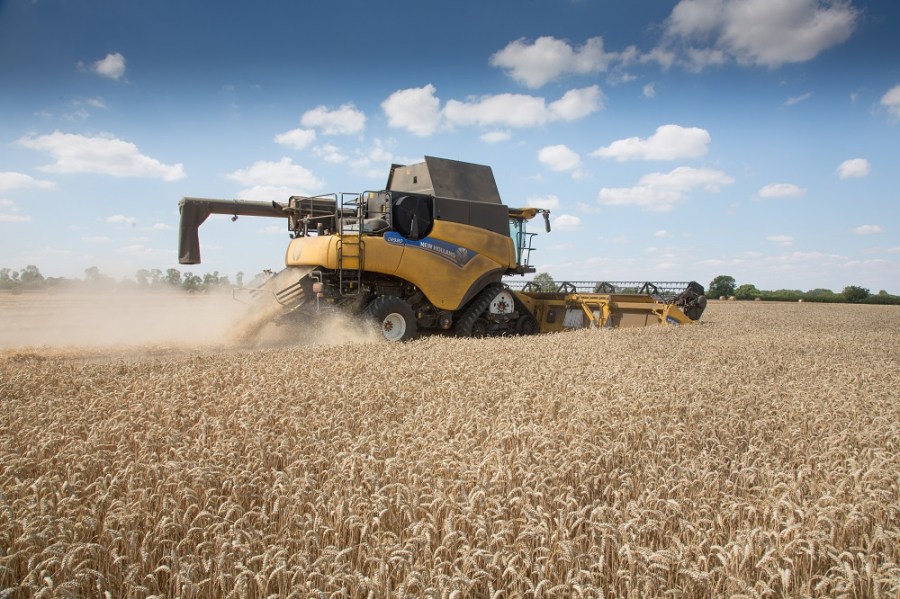Will Reflection deliver on its promised potential this harvest? CPM canvases views from some of the growers aiming to beat their best yield with the variety and seeks expert insight.
We’ve done everything we can for the Reflection. The only thing it’s short of is sunshine.
By Tom Allen-Stevens
As combines progress through harvest, initial reports from early crops indicate 2016 is not going to be a year celebrated for its high yields.
“I’ve been very frustrated with harvest,” comments Wilts grower James Stafford. “Oilseed rape has been particularly disappointing – I think it’ll struggle to manage as much as 3t/ha.”
As such, he’s tempering his expectation from his Reflection winter wheat. “It looks OK – not bad but not great.”
In Lincs, Charles Anyan is “fairly hopeful” for his Reflection. “It has plenty of ears and by the looks of things, it’s not as badly affected as others by fusarium, that’s been a big worry this year.”
Poor start to harvest
But harvest for him so far has been “disaster management”, with OSR achieving 3.8-3.9t/ha, and no barley cut by the beginning of Aug.
Near Ipswich, Pip Partridge is “pretty disappointed” with the 6t/ha he’s getting from his winter barley. “It’s a poor

James Stafford’s crop really picked up with the first dose of N and put out a lot of tillers.
sample with low specific weight – the grain just never filled.”
The Reflection, on the other hand, looks to be the best wheat on the farm, he says. “It does look a consistent crop and the ears seem to be filling well.”
Harvest hadn’t yet got underway on Sunk Island, just north of the Humber, where Jono Dixon admits he can’t bear to look too closely at his wheats as a result of disappointing blackgrass control.
“We’ve done everything we can for the Reflection. The only thing it’s short of is sunshine, but that’s something we’ve no control over.”
Just south of the Humber, Chris Hewis is reasonably upbeat about his crop. “It looks very well, with big ears. The question is: will it yield?”
His winter barley hasn’t performed as bad as the “horror stories” he’s heard. “Harvest is frustratingly delayed and slow, though, with OSR not a record breaker at just 3t/ha.”

Charles Anyan reckons his Reflection isn’t as badly affected as others by fusarium.
In Herts, Andrew Watts has reduced his OSR acreage, and is wondering whether to cut it further, after his crop, beset by cabbage stem flea beetle, yielded just 2.5t/ha.
He’s just combined some early wheat – a niche French white wheat variety – that’s put in a more average performance. “The Reflection looks OK, following the early season panic. The combine will be the test for it.”
They’re among ten #Clubhectare growers, who’ve taken up the challenge to beat their best yield with Reflection. They’ve been sharing regular updates throughout the season via Twitter, and picked up expert advice on how to maximise the variety’s potential. They’ll also be among the growers contributing to regular updates provided throughout harvest at www.syngenta.co.uk/reflection/yield-map
Near Corsham in Wilts, James Stafford’s soil type varies from silty clay loam to Cotswold brash, and it’s that mix of soil that lies beneath his 17ha of Reflection. “We’ve a strip of Revelation in the field as a comparison. The Reflection’s further forward, but otherwise both look reasonable.”
The crop was established with a 6m Kverneland TS Evo drill, following a Lemken Terradisc to make the seedbed,

Pip Partridge is using a bit of ‘muck and magic’ to improve rooting and nutrient uptake.
which was then rolled and sprayed. “The Reflection looked a little behind over the winter, then really picked up with the first dose of N and put out a lot of tillers – it came on well.”
It received 220kgN/ha and a four-spray fungicide programme, including an SDHI at both the T1 and T2 timings, with manganese and Bittersalz added to keep the crop from wanting anything, he says. “We’ve done everything we can – you could see that the chemistry worked from a small spray miss I had near a telegraph pole.
“It’s not big, barn-busting land this, with wheat yields averaging 8.6t/ha, so it would be nice if the Reflection did a bit better.”
Charles Anyan’s 6.8ha crop of Reflection was hit by yellow rust after the T0 spray had gone on. “The T1 stopped the disease in its tracks, and it’s been clean ever since, but it’s fusarium that concerns me now. Once the T3 spray has gone on, there’s nothing you can do about it, but I’ve seen plenty around and it can knock 2.5t/ha off yield.
“The interesting thing is that the Reflection seems to be holding the disease off, so I’m reconsidering it as a variety for next year – yellow rust is a disease we can manage, but fusarium is far tougher to control.”
Looking good all season
The Reflection was drilled into his “kindest” sandy clay-loam field with a 6m Kuhn Megant, following plough and power harrow after OSR. It tillered well and looked good all season, he says, receiving a total of 220kgN/ha.
“I’m fairly open-minded about what to choose for next year. A lot depends on yield performance this harvest, but you’ve also got to keep cost of production in mind. So Graham may be a contender, and we’re sticking to Skyfall as our main Group 1 variety. After that, we’ll make a judgement when the combine’s gone through.”
Pip Partridge is also considering growing Graham for its yield potential and good disease resistance. “But equally we can tend to cast varieties aside too quickly, and it’s worth getting to know one. So if Reflection does well, we may keep an area of it for next year.”
This year, his 30ha crop of the variety lies on Hanslope clays to Melford series heavy loams. It was established at 350 seeds/m² on the last day of Sept with starter fertiliser applied through the Väderstad Rapid. “The crop really flew out of the ground and looked fantastic,” he reports.
It received 200kgN/ha and a four-spray fungicide programme, including SDHIs at both T1 and T2 with Amistar Opti (azoxystrobin+ chlorothalonil) added at T1 to check the yellow rust.
“We’re also using a bit of ‘muck and magic’ – we put some Mega-Fos (phosphite) on with the T0 and T1 sprays to improve rooting and nutrient uptake, so have tried every aspect to pull out the potential.” As a first wheat, he’s hoping for a 10t/ha crop, although his average, including second and third wheats, is 8.5t/ha.
Either side of the Humber, there’s a bit of competition over who’ll do best. On the north side, Jono Dixon has an 8ha crop of Reflection on warp land following vining peas. It received chicken manure, then 190kgN/ha, a full, four-spray fungicide programme, and didn’t see too much of the blackgrass that’s afflicted his other wheats.
“But I’m not confident it’ll yield this season because of the poor weather. I reckon Chris Hewis may outdo me – he is to growing crops what Delia is to cooking and always seems to pull it off when the odds are stacked against him. I think his Reflection may even be sitting on the same seam of soil as mine.”
Just across the water in N Lincs, Chris “Delia” Hewis isn’t so sure. “I wouldn’t like to say I’ll outyield Jono as I reckon his soil has more body. Having said that, the Reflection does look well and should yield.”
He missed the T0 spray window and the T1 application was 10 days late as a result of poor weather. “So we did get yellow rust in the early stages and I thought it would be a disaster. But the combination of chemistry and adult plant resistance seems to have helped it grow away from the problem and it now looks like it has potential.”
Epoxiconazole plus fenpropimorph plus metrafenone was applied at T1, with an SDHI base to the T2 spray. Priori Xtra (azoxystrobin+ cyproconazole) has kept the ear clean since the T3 timing, he says. “Next year, we’re looking for varieties with disease insurance, so will stick with Evolution and Dickens and may look at KWS Siskin or Graham.”
Having to apply a T0.5 spray to keep the yellow rust out of his 5ha of Reflection has knocked confidence in the variety for Andrew Watts, who’s growing it within a 30ha block of JB Diego on “fairly stiff” clay loam.
“Since then it’s looked OK. We’ve treated it the same as all the other wheats and the Reflection has a big ear, so should perform. But the only certainty about a high input, high output variety is the high input, and I’m not sure that’s a risk we can take with a wheat that we’ll grow across hundreds of acres. But let’s wait and see what harvest brings,” he says.
Absorption’s the key to Reflection’s potential
Just how much influence does the weather have on crop potential, and has this year’s dismal summer knocked it sideways? According to Prof Roger Sylvester-Bradley of ADAS, light interception and water availability are the two factors that determine whether you reach the genetic potential of your crop.
“That’s not to say that disease isn’t important, and in a year like this one, it’s very hard to keep disease from compromising potential. But crop inputs, such as sprays, fertiliser and even micronutrients, just facilitate the output. Light, water and carbon dioxide are the real resources from which yield is built.”
There’s a staggering 36 terajoules of sunshine energy that falls on a ha of wheat, he says – about half a Hiroshima bomb – and the aim for the plant breeder and grower is to turn that into crop biomass through photosynthesis.
“Ever since John Monteith’s work at Sutton Bonington (Nottingham University) in the 1960s and 70s, we’ve had a good understanding of the relationship between light interception and growth,” he explains.
“Up until the mid 1990s, however, breeders increased yield potential through raising harvest index – the proportion  of grain to overall biomass – and farm yields increased accordingly. But since then, yield potential has improved through increasing biomass and the lifespan of the canopy, and I have a theory we haven’t focused enough on-farm practice towards harnessing that potential, which is why yields have stagnated.”
of grain to overall biomass – and farm yields increased accordingly. But since then, yield potential has improved through increasing biomass and the lifespan of the canopy, and I have a theory we haven’t focused enough on-farm practice towards harnessing that potential, which is why yields have stagnated.”
This is what the Yield Enhancement Network (YEN) is designed to do, says Roger Sylvester-Bradley. “Much of the land in the UK is capable of achieving 20t/ha, depending on rainfall and soil water-holding capacity. YEN members are given a yield potential for their land – anyone who exceeds the average of 58% is doing well. The record is 81%.”
Above ground, maximum light interception is the key, he says, and that comes down to ensuring a canopy that has optimum efficiency. “You’re looking for a green area index (GAI) of 6-7 by the time the crop reaches flowering. But that assumes all the leaves share the light energy fairly evenly.”
To illustrate, he points out the difference between a rhubarb and an iris leaf. “You would have thought the surface area of the rhubarb leaf would help it intercept more light. But leaves have a limited capacity and saturate at low light intensity. So what you look for is an erect plant architecture so leaves can share the light.”
Syngenta senior wheat breeder David Feuerhelm points out that Reflection is noted for its erect growth and short, well positioned leaves. “It also has the ability to produce a lot of tillers and retain a high number of ears. While other high-yielding varieties have an extended canopy life to realise their potential, Reflection occupies its space well to intercept the light, which is what gives the variety its edge.”
The Syngenta wheat-breeding programme has sought to produce wheats with a range of maturities, he says. “Graham matures earlier than Reflection, while our two NL2 candidates are on the late side. AHDB Cereals and  Oilseeds Recommended List candidates Shabras and Savello fall between Reflection and Graham.”
Oilseeds Recommended List candidates Shabras and Savello fall between Reflection and Graham.”
Graham is a little taller than Reflection, and being earlier, will reach critical growth stages at a different time, he notes. “The way Tim Lamyman ensured a record-breaking yield with his Reflection was to ensure it was kept stress-free throughout its growth. The same would go for Graham, but follow the crop growth to get the timing right.”
Roger Sylvester-Bradley notes that this year, sunshine levels for June and July are down on average, and that will
reduce the amount of energy that crops will have received. “But we shouldn’t jump to conclusions, and moisture levels are higher, which is the other common limiting factor,” he points out.
“What’s of far more relevance is whether you’ve nurtured your crop and managed your soil in a way that addresses the more limiting of the two key resources that determine crop potential – light energy or water.”




